Before we begin today’s post. I just wanted to mention that these are just some of the basic guitar chords for beginners.
These are some of the chords you will see most frequently when learning songs on the guitar.
If you want to learn these chords faster, take a look at my full review of the best online guitar platform to date.
Contents
- 1 What you will learn in today’s free lesson:
- 2 What Is A Chord?
- 3 What Are Some Other Types Of Guitar Chords
- 4 Different Types Of Chords
- 5 Root Chord
- 6 The Minor Chord
- 7 Barre Chords
- 8 Learn The 5 Basic Chords First
- 9 Learning How To Read A Chord Diagram
- 10 There Are Frets
- 11 Dissecting the Chord Diagram Once more
- 12 The Major Chords
- 13 A Major Chord
- 14 B Major Chord
- 15 C Major Chord
- 16 D Major Chord
- 17 E Major Chord
- 18 F Major Chord
- 19 G Major Chord
- 20 Minor Guitar Chords
- 21 A Minor Chord
- 22 B Minor Chord
- 23 C Minor Chord
- 24 D Minor Chord
- 25 E Minor Chord
- 26 F Minor Chord
- 27 G Minor Chord
What you will learn in today’s free lesson:
- What Is A Guitar Chord?
- The Top 5 Chords Played On Guitar
- How To Read A Guitar Chord Diagram
- How To Play 14 Of The Basic Guitar Chords
- What Guitar Chords You Should Learn First
- Basic Guitar Chord Finger Placement
- BONUS: 3 Famous Chord Progressions
What Is A Chord?
A chord is a sound that a guitar makes when three or more notes are played at the same time.
Basic guitar chords can easily be made into simple songs.
There are thousands of recorded songs that all they do is play the basic guitar chords throughout the entire song.
But, the most important thing in learning guitar chords is to remember, they are three or more notes.
The basic three note chords are called Triads and are usually related to each other based on the scales, which is music math that we aren’t going to get into.
Basically, these three notes sound great together and not like a cat on a chalkboard.
And, there are open chords, these are chords that use the open strings and don’t require any figure positioning.
What Are Some Other Types Of Guitar Chords
There are all kinds of Basic chords, Barre Chords, Drop 2 Chords, and Drop 2 and 4 Chords that can be played on the guitar.
However, these are not something for the first time player but something that you can build towards.
The first set of chords that a new guitarist should make are A-E-D-C-G Major and minor will come next, as it is only a slight difference in finger positions.
( We will show you how to play these chords later in the article).
And, the names of the minor chords will have a small “m” after them. Such as Em this stands for “minor” in the note.
There are also notes with a b after them, Eb, and the b stands for flat. Each of these notes will be played with your fingers on certain strings of the guitar up at the neck area.
Different Types Of Chords
Basic Chords are where all of the rest of the chords come from.
Literally, all the different types of chords start with the 5 basic chords with the guitar. So, learning these chords well is important.
These 5 basic chords are E – G – C – A – D – Major and are the fundamental hand positions. However, it is important to not only learn each cord but to learn the notes that each cord makes up if you really want to be a guitar player and not just strum a few songs.
If you really know and understand the hand positions as well as the notes there are literally 1000’s of chords that you can play with your guitar.
A chord consists of 3 or more strings being played at any given time. This is important as there are lots of information out there, but if they call 1 note or 2 note strums a chord, this is incorrect.
Root Chord
A root chord is the lowest sounding note in a chord. It is essentially the “key” to that chord.
If you are playing a chord where the root chord was a “C” then you would be playing a C Major.
Look at the basic finger diagrams and find the lowest cord in that chord. It doesn’t matter if your chord is minor, diminished, major or augmented, the root note is always the same.
The Minor Chord
These are spin-offs from the basic chords, as the basic chords are major cords, these are the minor.
And, they will have a min. or m after the root chord letter. Three notes make up this chord, the first, flat – third and fifth.
These are one of the most important chords to learn along with the basic chords.
Once you learn the basic chords, these have the same finger positions but are down one fret.
This means that you have essentially learned these chords as well. The minor chord’s sound is usually described as sad.
Barre Chords
Barre chords are chords that can be some of the hardest for a new player to master. But, to become a complete rhythm guitarist, it is important.
(Tip: If you want help learning barre chords faster, I highly recommend this learning platform, it has and still does teach me new things daily.)
These are found in guitar diagrams all over as well, and these diagrams have where to place your fingers on the strings and in what fret. But they will have a swish or rainbow type shape on the top under the letter name.
These chords are actually made from another basic cord but are moved down on the fret bar. Down on the fret means closer to the guitar body.
So, for example, there is an F major barre chord have similar fingerings that E has but drops down a fret.
Learn The 5 Basic Chords First
Some songs actually only use basic guitar chords to make the music. There are 5 basic guitar chords.
Guitar chords are notes that are played together to create a specific sound. There is certainly more than 5 total, however, the other remaining guitar chords are basically a spin-off from this basic 5.
Learning these very well will help you be a great guitar player in the future.
Learning guitar can be so much fun. First, start with the basics in guitar chords and master those before trying to move on to the next level.
Learning the guitar is best done in layers, mastering one phase before moving to the next. There are all kinds of things to learn when playing guitar and it’s a lot of fun.
Learning How To Read A Chord Diagram
First up, we need to learn how to actually read a chord diagram the correct way.
The chord diagrams are not as complex to read as one might think. However, diagrams can be found all over the internet for various chords. But an explanation on how to read them is always helpful.
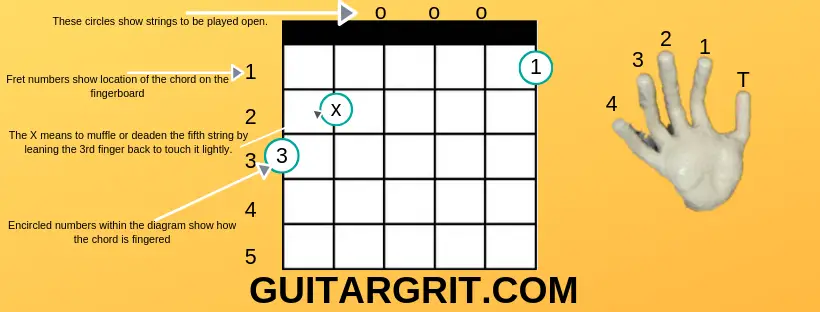
Most diagrams have a letter at the top and some boxes with dots on the boxes and some numbers.
It kind of makes you think you might be playing a new game of Sudoku, but it’s not.
The very dark line across the top of these charts represents the top of the guitar fret-board (On the neck of the guitar.). This is called the guitar nut, but that’s not really important, just knowing where it is located is.
This is the area that sends the strings over the frets, small horizontal boards on the neck of the guitar.
There Are Frets

The boxes below represent the frets.
So, the first row of boxes below the dark line is the first fret, the second row is the second fret, the third is the third all the way to the fifth.
Again, the frets are the sections on the neck of the guitar that is sectioned off by horizontal lines.
The vertical lines in all the diagrams are the six strings on the guitar.
The line furthermost to the left is the sixth string and the thickest string on the guitar.
This is the string that when holding the guitar is on top, for right-hand players. Or it’s the string closest to your head if that helps.
Now, for those pesky numbers.
The numbers are telling you what finger to place on each string.
But, this isn’t actually set in stone, as some players prefer a different finger stance, which you will get with time and practice.
But, for now, the number one starts at the index finger and the number 2 is the middle and continue to the pinky is number 4.
Sometimes you might see a “T” instead of a number, yep, that means use your thumb to fret a particular note.
These can be somewhat confusing at first I have put together a diagram explaining how to read a guitar chord chart.
I have also listed some of the basic guitar chord shapes on here, but don’t worry we’ll be going over these in detail later on in the post.
Just to recap:
The String numbers go down vertically.
While the frets of the guitar go across horizontally.
The numbers to the far left show what fret you are on.
The Letters below show which note of the chord you are playing.
An X means to mute or not play that string.
An O means to strum the string open while strumming the chord as a whole.
Here is another chord explanation picture to really drive home how to read these simply, and effortlessly once and for all.
Dissecting the Chord Diagram Once more
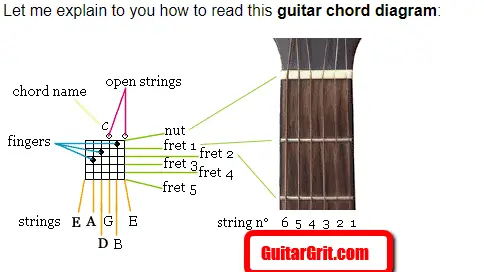
Now that we have a grasp on how to use a chord diagram let’s dive in to our top 14 guitar chords every beginner guitarist must know!
The Major Chords
A Major Chord
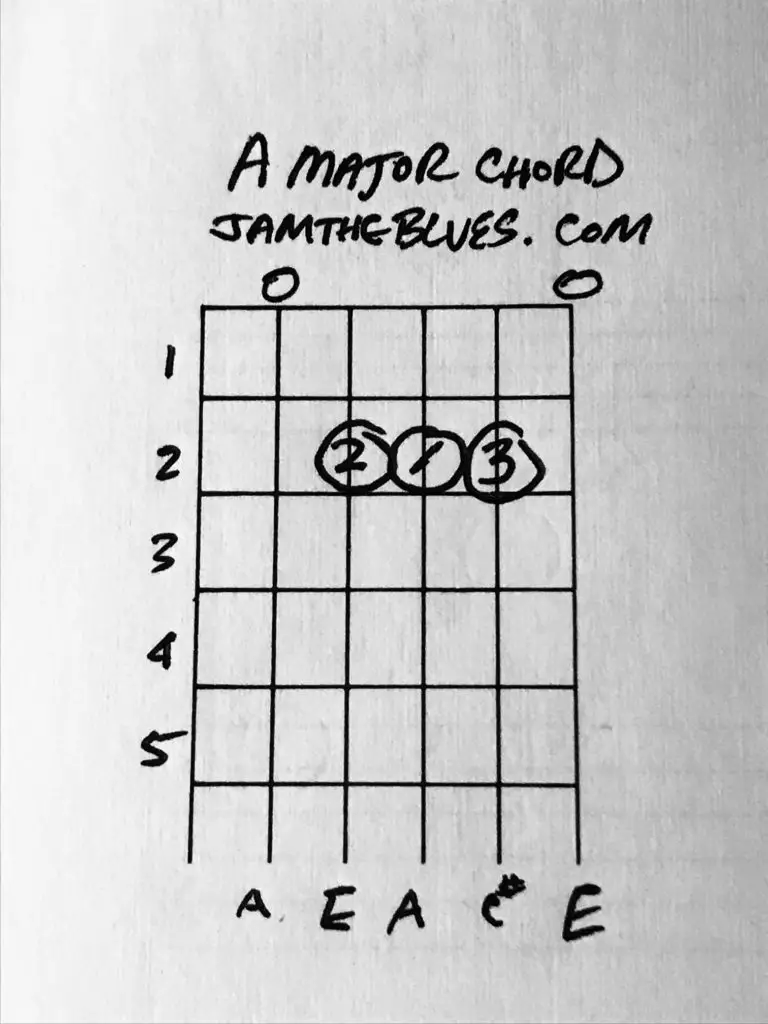
The A Major Chord is derived from the A major scale. There are 3 sharps in the A major scale.
The A Major scale is A, B, C#, D, E, F#, G#, A
The A Guitar Chord is made up of the 1,3, and 5th notes of the scale.
A – C# – E
B Major Chord
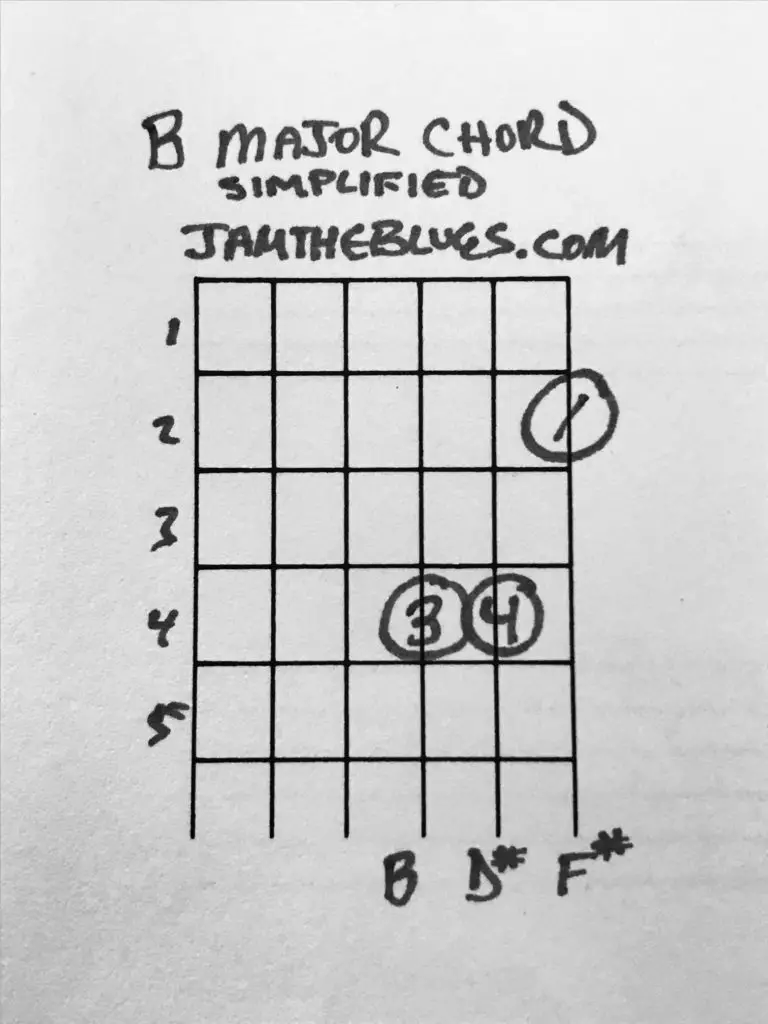
The B Major Chord derives from the B major scale. There are 5 sharps in the B major scale.
The A Major scale is B, C#, D#, E, F#, G#, A#, B
The B Major Chord is made up of the 1,3, and 5th notes of the scale.
B – D# – F#
See the B Major Chord all the way up the neck
C Major Chord
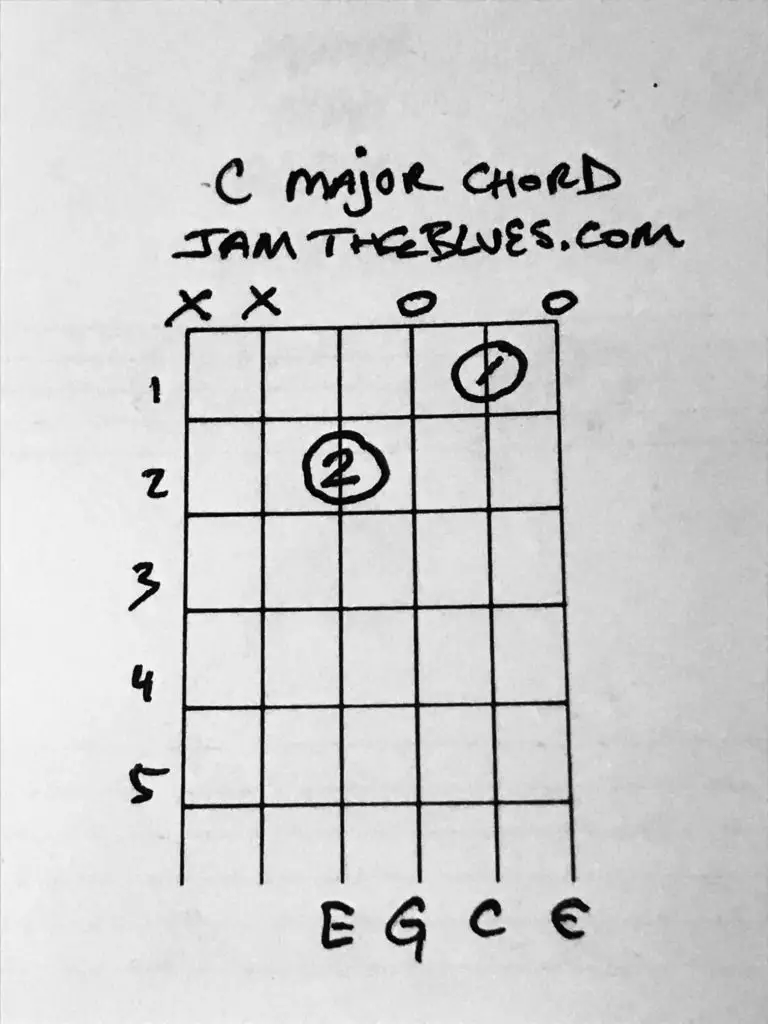
The C Major Chord derives from the C Major Scale. This scale has zero flats or sharps in it.
Therefore it looks like this C – D – E – F – G – A – B
The A Major chord is made up of the 1,3, and 5 notes of the scale.
C – E – G
D Major Chord
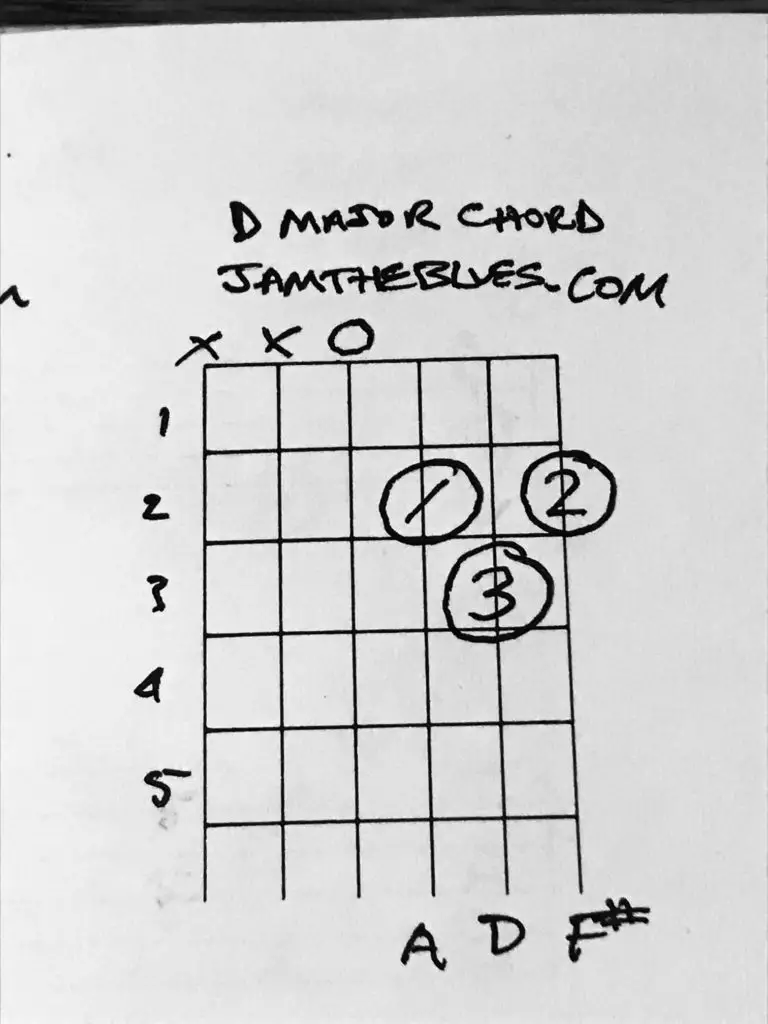
The D Major Chord derives from the D major Scale. This scale has 2 sharps in it. F# and C#
This scale looks like this. D – E – F# – G – A – B – C#
The chord is made up of the 1, 3, and 5th notes of the scale.
D – F# – A
E Major Chord
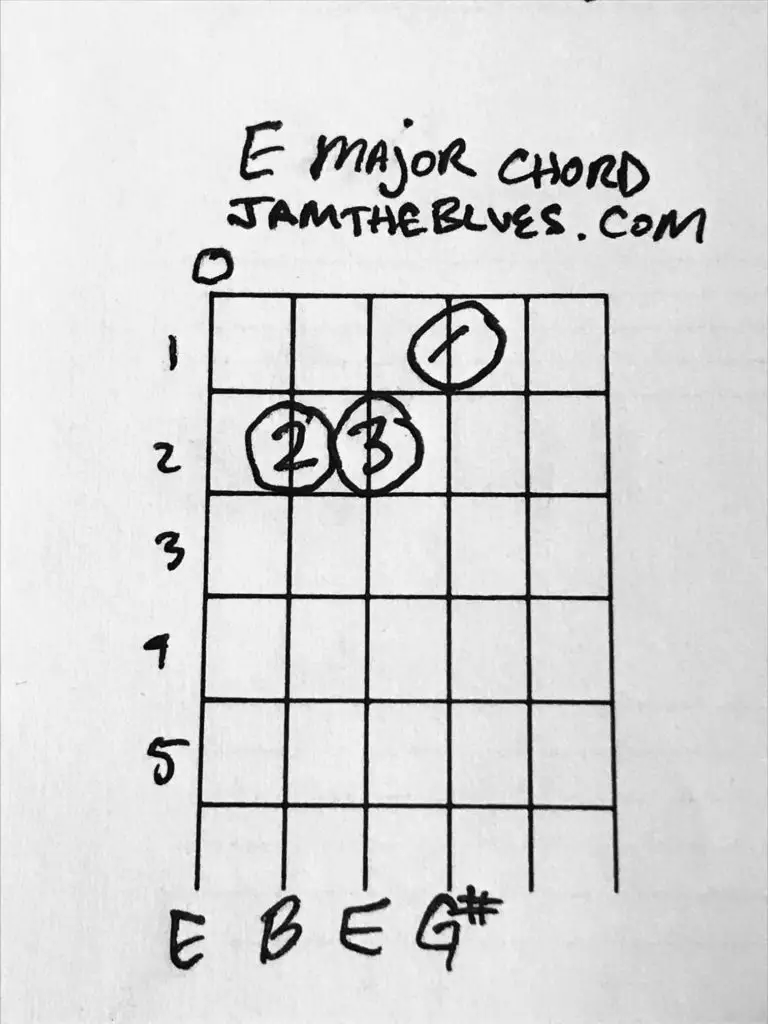
The E Major chord comes from the E major scale. This scale has 4 sharps in it.
This scale looks like this. E, F#, G#, A, B, C#, D#, E
This chord is made up of the 1, 3, and 5th notes of the scale.
E – G# – B
F Major Chord
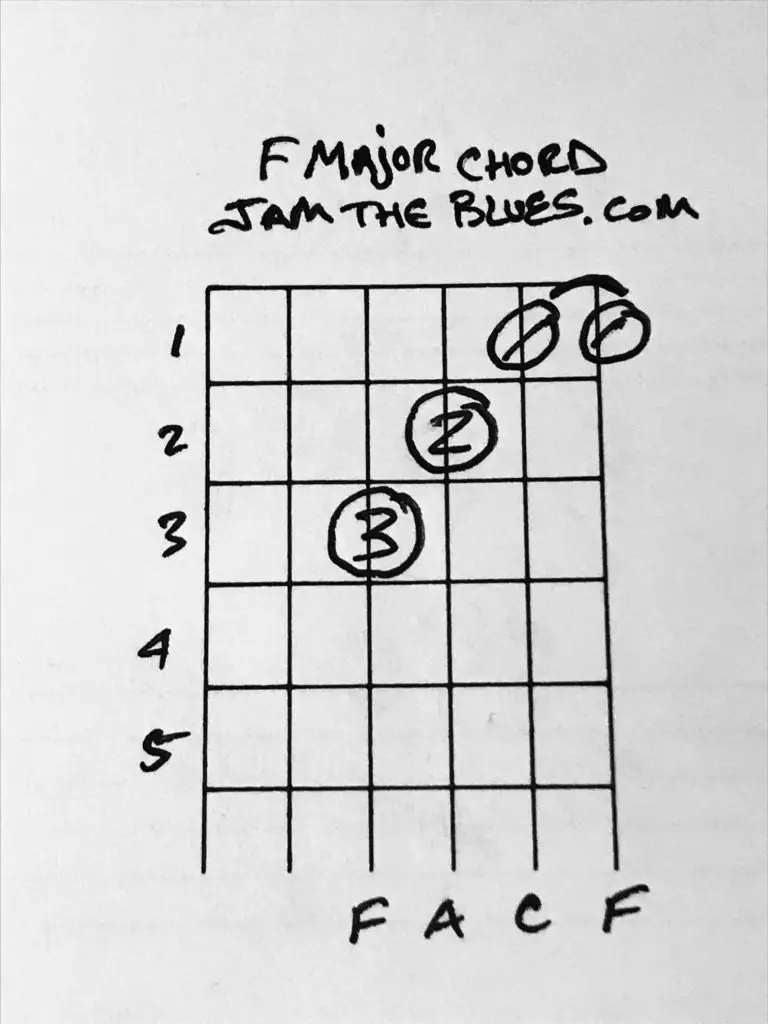
The F Major Chord comes from the F Major scale. There is one flat in this scale.
This scale looks like this F, G, A, Bb, C, D, E, F
This chord is also made up of the 1,3, and 5th notes of the scale.
F – A – C
G Major Chord
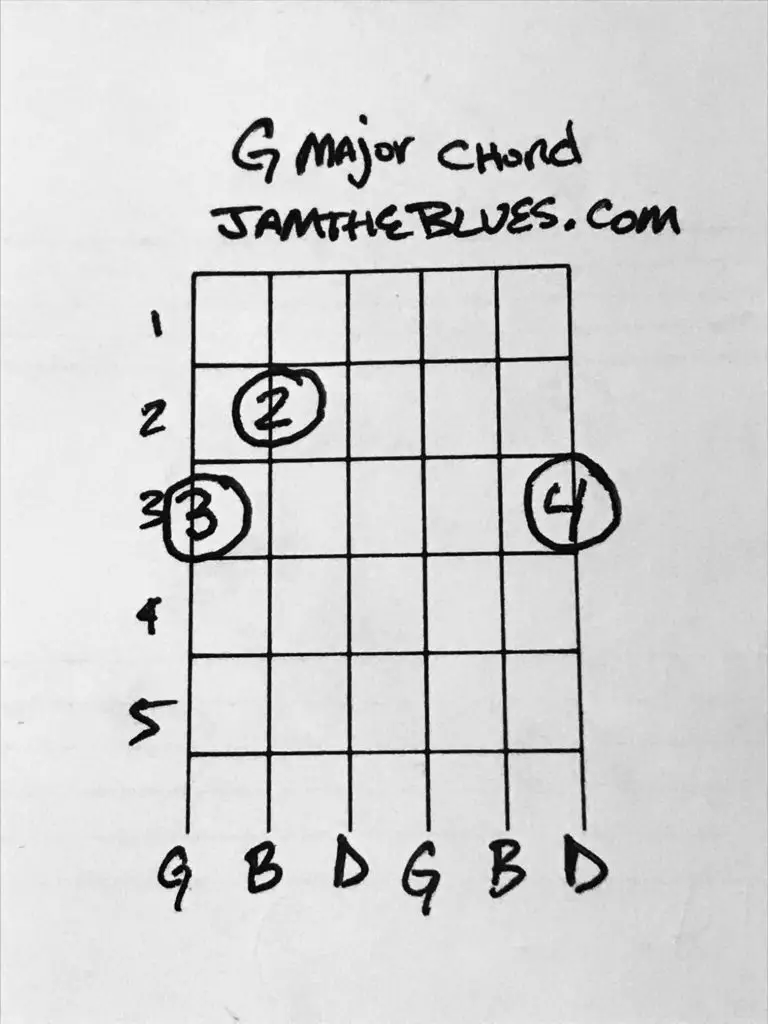
The G Major Chord comes from the G Major scale. There is 1 sharp in this scale.
This scale looks like this. G, A, B, C, D, E, F#, G
This chord is also made up of the 1, 3, and 5th notes of the scale
G – B – D
Now it’s time to switch gears and also go from a happy sound, to a darker sound.
Next up, is looking at the Minor guitar chords.
Minor Guitar Chords
A Minor Chord
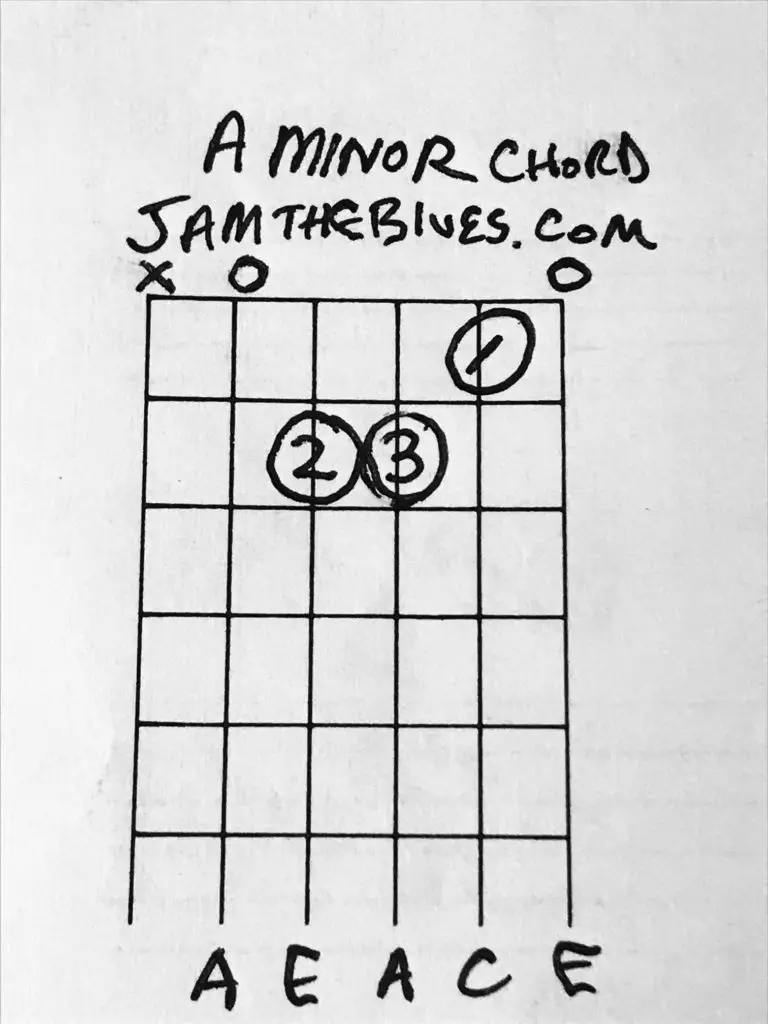
The A Minor Chord derives from the A Minor Scale.
This scale has zero sharps and flats and looks like this. A, B, C, D, E, F, and G
This chord is made up of the 1, 3, and 5th notes of the A Minor scale.
A – C – E
B Minor Chord
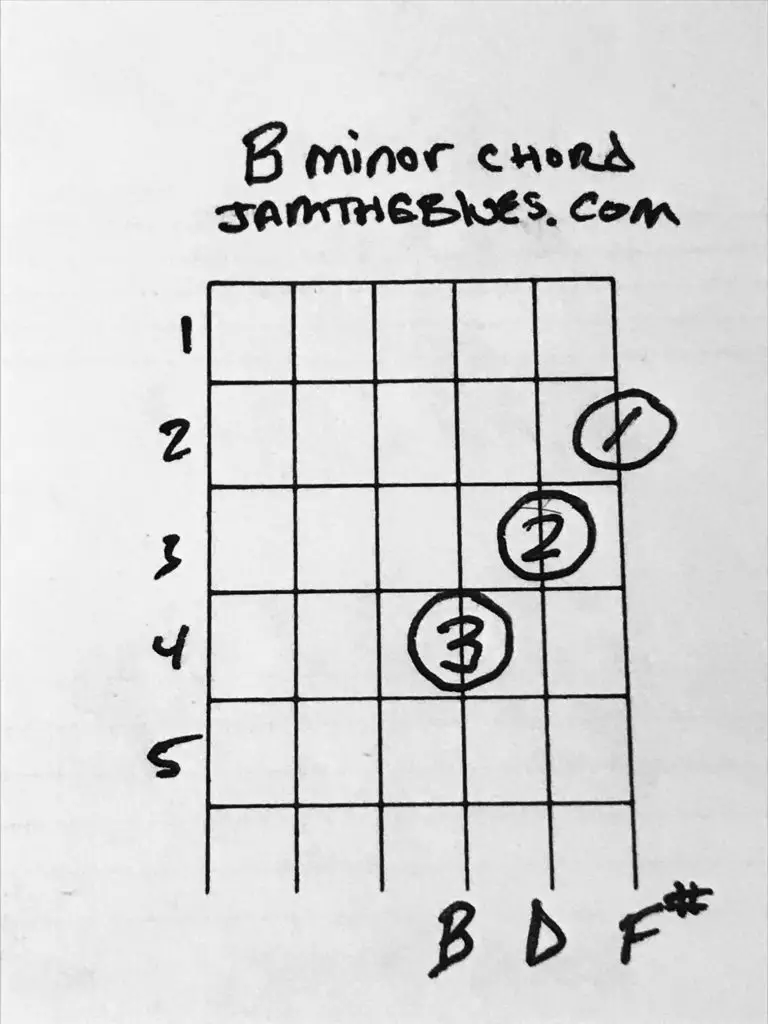
The B Minor chord derives from the B Minor scale.
This scale has 2 sharps in it and looks something like this.
B, C♯, D, E, F♯, G, and A
Chord shape consists of A – E – C
C Minor Chord

The C Minor chord comes from the C minor scale.
This scale has 3 flats and looks like this. C, D, E♭, F, G, A♭, and B♭
Chord shape consists of the 1st, 3rd, and 5th notes of the scale
C – E flat – G
D Minor Chord
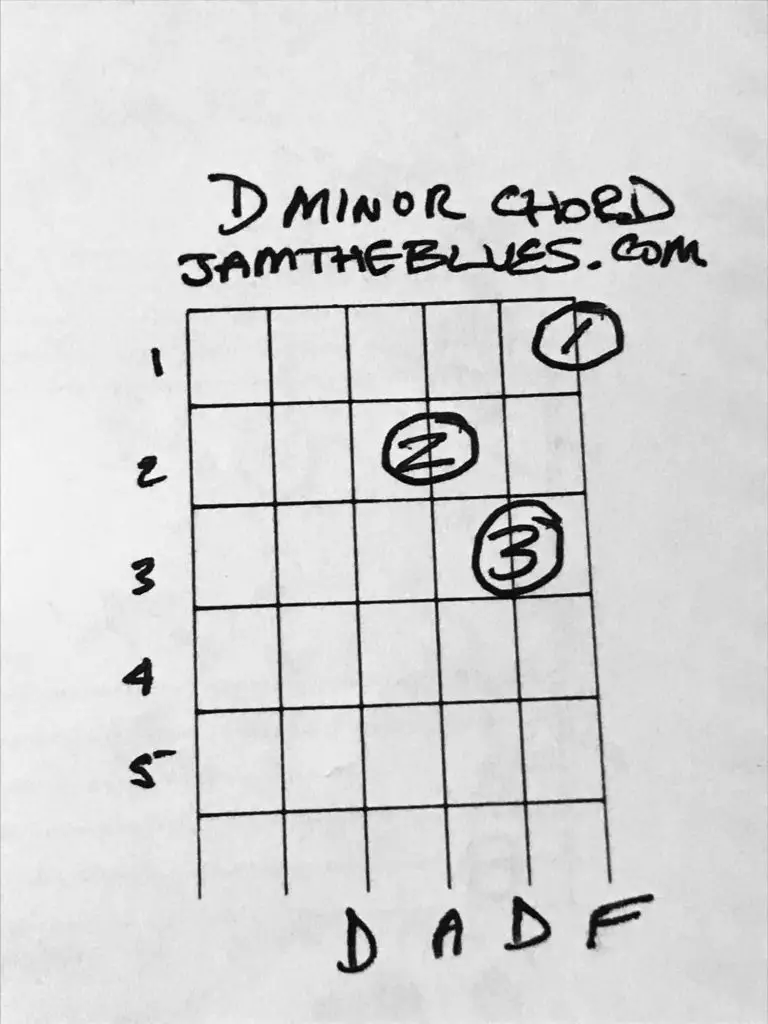
The D Minor chord comes from the D minor scale.
This scale has 1 flat in it, and consists of these notes D, E, F, G, A, B♭, and C
The Chord shape consists of the 1,3, and 5th notes of the scale.
D – F – A
E Minor Chord
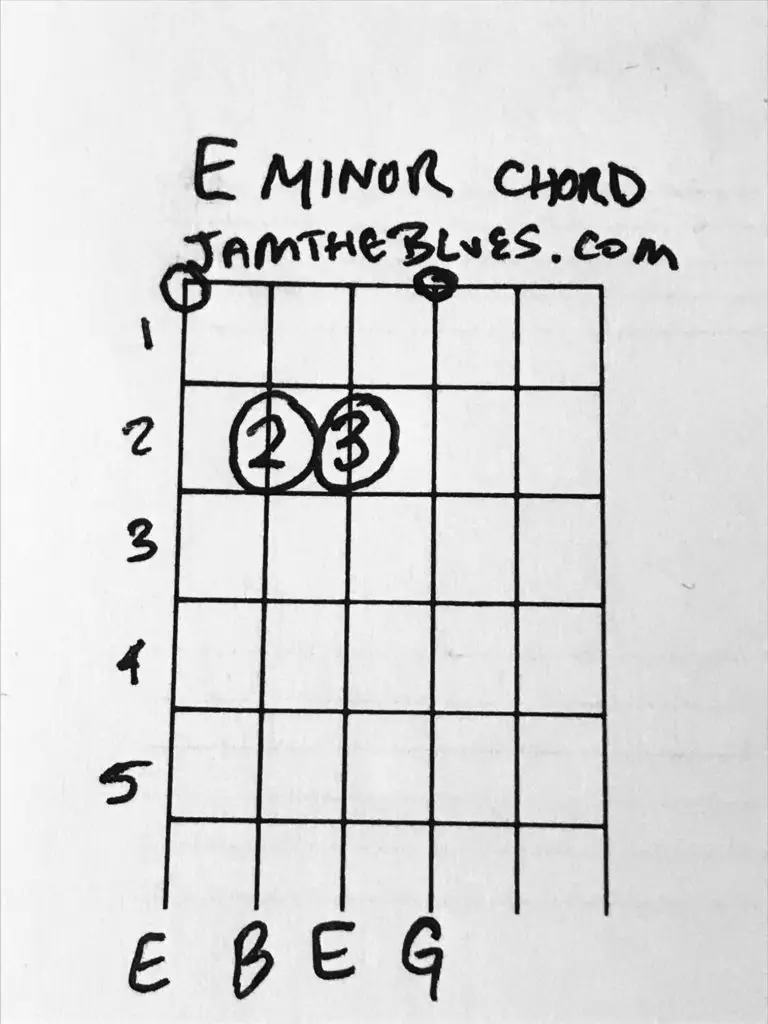
The E Minor Chord comes straight from the E minor scale.
This scale has only 1 sharp in it and looks a little like this. E, F♯, G, A, B, C, and D
The chord shape has the following notes inside of it.
E – G – B
F Minor Chord

The F Minor Chord comes straight from the F Minor Scale.
This scale has 4 flats in it. A flat, B flat, D flat, and E flat.
The scale notes look like this. F, G, A♭, B♭, C, D♭, and E♭
The chord shape has the following notes
F – A flat – C
G Minor Chord

The G Minor Chord comes from the G minor scale.
This scale has 2 flats in it. The B flat and the E flat.
This scale looks like this. G, A, B♭, C, D, E♭, and F
The chord notes that make up the G minor chord are as follows
G – B flat – D
Which chords should you learn first?
The first chords that I would learn on guitar are
- A Major
- C Major
- D Major
- E Major
The reason I have chosen those 4 chords to start with first, is that they are all great open chords.
What I would recommend doing is learning those 4 basic chords, and then getting out a metronome and try and switch every measure, then during the measure, then even possibly every beat of the measure.
( Remember to do this slowly). This isn’t a race. If you need to set a metronome to as low as 60, I’m fine with it. Quality chord changing is as important as knowing the chord itself.
Basic Guitar Chord Finger Placement
Something that you want to do is to pay very close attention to what numbers are being shown on the chord diagram.
Often people opt out on using their pinky finger. This is actually a huge mistake. As you progress as a player you will want to be able to play things with your pinky finger.
If you choose not to use it, that ‘s fine. Just realize that you are not going to be able to do what you might want to down the road.
The easiest Guitar Chord
The easiest guitar chord to learn is probably an E minor chord. You only have to make use of 2 fingers. They happen to be on the same fret. There is no barring of any of the strings, and you can strum all the strings.
All of these facts leave me to believe that an E Minor chord is probably one of the easiest chords to learn.
Also I should mention that it’s an awesome sounding chord and many songs have used an E Minor, it’s quite a popular chord due to its dark sound.
Beginner guitar chord progressions
One of the most famous chord progressions is called the 1, 5, 6, 4 progression. This is simply where you play the root chord followed by the chords equivalant chords based off its scale. For example in the key of C, the common chord progression would look like this.
C – G – A minor – F
Once you have mastered all of these chords you can move on to full barre chords. Until you can play these by memorization, and switch between chords without having to even think about it. This is when it’s time to progress into more chord progressions and voicings.
Which chords will you master first?



